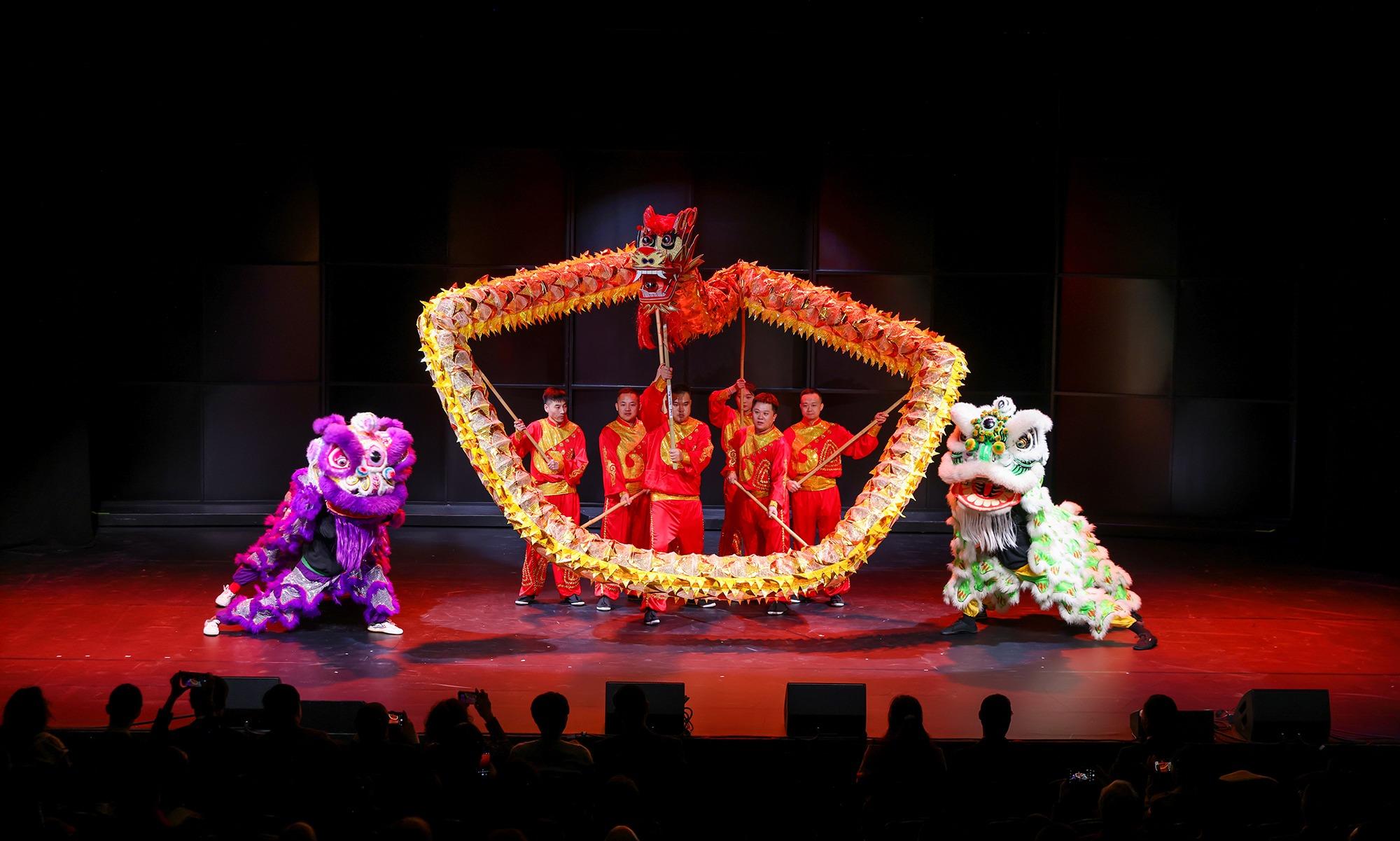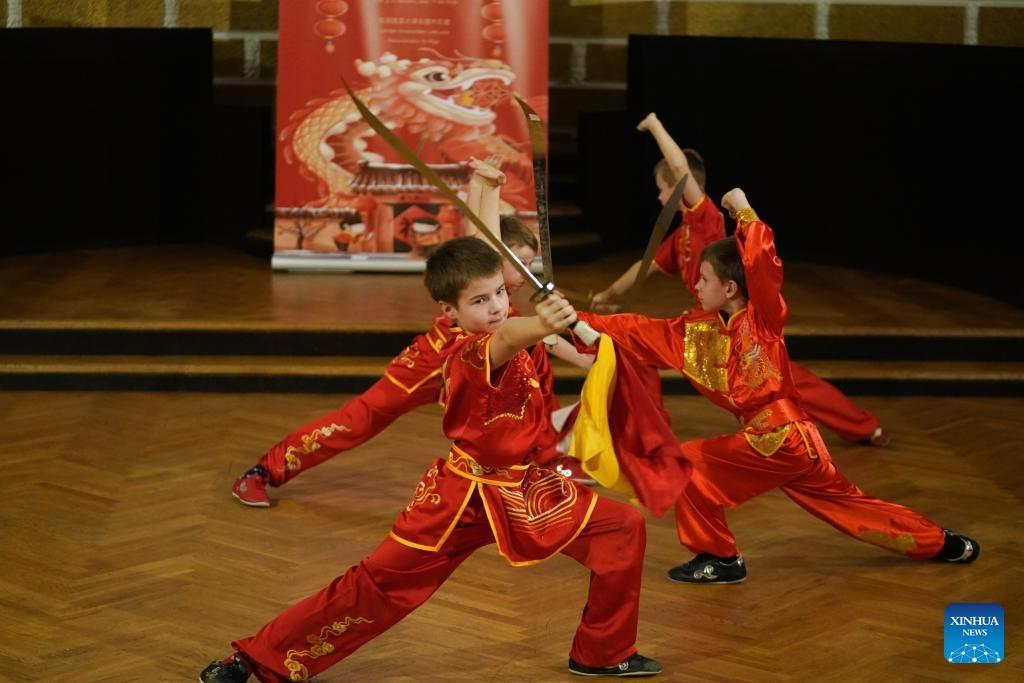 A Chinese dragon dance group and a Finnish lion dance team perform together in Helsinki, Finland, on Feb 5, 2024. (PROVIDED TO CHINA DAILY)
A Chinese dragon dance group and a Finnish lion dance team perform together in Helsinki, Finland, on Feb 5, 2024. (PROVIDED TO CHINA DAILY)
In a huge show of cultural unity, Finland and Estonia are hosting a series of events to mark the Chinese Lunar New Year, also known as Spring Festival in China, which falls on Saturday.
Fifteen events including six performances, three photo exhibitions and three workshops showcasing Chinese culture are being held as part of the "Happy Chinese New Year" celebrations in the two European nations.
The festivities, which started on Monday and run through Saturday, feature folk artists, dancers and musicians from Beijing. The Confucius Institute of the University of Latvia in Riga, Latvia also held and event celebrating the the Spring Festival on Monday.
READ MORE: UN chief extends Lunar New Year greetings to all Chinese
Liu Weizhi, deputy director of the Beijing Overseas Cultural Exchange Center, the organizer of the events, said the Chinese New Year celebrations have become an annual program in Finland and Estonia. While Finland is hosting the 18th edition of "Happy Chinese New Year", Estonia is hosting the 15th.
"This Spring Festival marks the start of the Year of the Dragon, which is a symbol of courage, vitality and good fortune in traditional Chinese culture. ... The ongoing events in the two countries have a lot of elements that feature the mythical creature," Liu said.
Helsinki, the capital of Finland, and Beijing became sister cities in 2006, and in 2007, "Happy Chinese New Year" events were held in Helsinki for the first time. One of the highlights was the dragon dance, featuring two 18-meter-long "dragons", performed by artists from Beijing.
Like the lion dance, the dragon dance is also a Chinese folk art form, in which performers maneuver the "dragon" using poles.
 Local students perform Chinese dance during an event celebrating the upcoming Chinese Lunar New Year, or the Spring Festival, at the Confucius Institute of the University of Latvia in Riga, Latvia, Feb 5, 2024. (PHOTO / XINHUA)
Local students perform Chinese dance during an event celebrating the upcoming Chinese Lunar New Year, or the Spring Festival, at the Confucius Institute of the University of Latvia in Riga, Latvia, Feb 5, 2024. (PHOTO / XINHUA)
The lead performers skillfully raise, lower, thrust and sweep the dragon's head, creating an engaging visual spectacle. All the performers work in tandem to maneuver the dragon's body, synchronizing the movements with the rhythmic beats of the accompanying percussion instruments played by a live band.
"Since 2007, artists from Beijing have traveled to Finland to teach dragon dance to locals interested in the Chinese folk art form," Liu said.
In 2019, a 10-day dragon dance workshop was held in Helsinki. "This year, locals who were trained by artists from Beijing are participating in the dragon dance shows along with eight performers from Beijing," Liu added.
ALSO READ: Lunar New Year to be celebrated in Serbia
Di Tianyao, project producer of the overseas cultural exchange center, said that in addition to dragon dance performers, Chinese folk musicians and handicraft artists, lantern maker Luan Xianwen and kite maker Zhang Lei have joined the new year events in Finland and Estonia.
Musicians from the Inner Mongolia autonomous region are showcasing folk instruments and techniques, including the morin khuur, or "the fiddle with a horse head", and khoomei, or "throat harmony".
The morin khuur is a two-string fiddle, the significance of which extends beyond its function as a musical instrument, for it was traditionally an integral part of rituals and everyday activities of the Mongolian nomads.
 Local students perform Wushu during an event celebrating the upcoming Chinese Lunar New Year, or the Spring Festival, at the Confucius Institute of the University of Latvia in Riga, Latvia, Feb 5, 2024. (PHOTO / XINHUA)
Local students perform Wushu during an event celebrating the upcoming Chinese Lunar New Year, or the Spring Festival, at the Confucius Institute of the University of Latvia in Riga, Latvia, Feb 5, 2024. (PHOTO / XINHUA)
Khoomei, which translates as "the root of the palate", is a special vocal technique in which one person produces multiple pitches simultaneously.
Di said that in 2020, they brought Haya — a unique band devoted to making world music based on Mongolian ethnic musical traditions — to Finland during the Chinese New Year festivities.
"Haya received great feedback from the local audiences, especially young people," he said, adding that the Chinese New Year celebrations have returned to Finland after the pandemic, and they aim to offer local audiences "more great musical traditions from Inner Mongolia".


